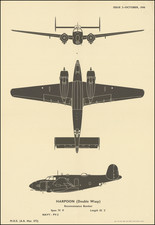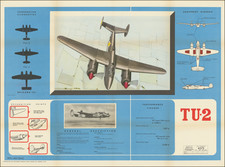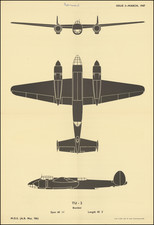Early Depiction of the F-84 Thunderjet
A very nice example from a series of posters produced by the British government to help identify aircraft. In the years following the Second World War, tensions grew between capitalist and communist powers. This resulted in a decades-long arms race where powers continuously developed bigger and better military technology. The paranoia generated by this tension created the need to produce material to help soldiers identify if a plane was a friend or foe. This small poster, printed by Fosh & Cross Ltd. (the primary printer of posters and propaganda for the British Government) in London, is an early example of this practice and shows the U.S. Thunderjet P-84. The P-84 Thunderjet (later reclassified as the F-84) was the standard fighter plane for the U.S. Air Force throughout the Korean War and served as a template for future jet-powered fights and bombers.
The poster features three silhouettes of the P-84 Thunderjet and a basic description of its capabilities like an operational duty as a fighter or its General Electric-made TG-180 turbo-jet engine. Something interesting to note is the date this poster was published. In the upper left is some text that states this poster, which is Issue One, was published in March 1947. This date is important to note as the P-84 had only begun testing a year prior. In fact, the Air Force found so many issues with the first design that the plane was still being worked on well into the late 1940s as the U.S. yearned for functional, jet-powered aircraft. After some of these issues were addressed, the P-84 went into full-scale production, becoming the main strike aircraft during the early Cold War and the Korean War.
The F-84 Thunderjet
Developed by Republic Aviation at the tail end of the Second World War, the P-84 was the U.S. Army Aircore's attempt to develop a jet-powered day fighter. After three years of additional tests, the P-84 officially entered service in 1947. The "P" in the name indicates this plane held the designation as a pursuit aircraft under the system devised by the U.S.A.A.C. The P-84 would soon change its name, though, due to the transformation of the Army Air Corps into the U.S. Air Force in 1948. The Air Force developed a new scheme to designate their planes. Rather than using the already assigned "P" for pursuit, the Air Force changed the aircraft designation to "F" for fighter. This difference was just in name, but it is important to note this development as it offers additional context for this print. This version is a very advanced copy that was produced in the year between the aircraft's release and the switch to the Air Force.
The reclassified F-84 Thunderjet first saw major action during the Korean War where it was used as a fighter-bomber. Initially, the F-84 was assigned the task of countering Soviet MiGs, but this mission proved to be better suited for the more agile F-86 Sabre. The F-84 soon became the primary strike and close air support craft for the U.S., flying 86,408 sorties throughout the conflict. A very solid aircraft, the F-84 would be mass-produced and given to many allied NATO countries where it continued to be used throughout the Cold War. Upgrades would be made as time progressed, with the F-84 holding the record for the first aircraft in U.S. history to utilize in-flight refueling. Although not the most iconic Cold War plane, the F-84 Thunderjet played a key role in asserting U.S. air superiority wherever necessary.









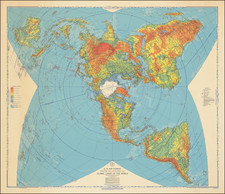
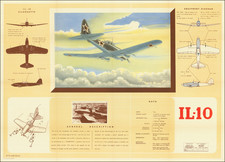
![[ European Cooperation ] Organisation Europeenne de Cooperation Economique](https://storage.googleapis.com/raremaps/img/small/78837.jpg)
